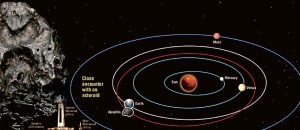‘Doomsday asteroid’ gone; back in 16 years
The asteroid called 99942 Apophis, long billed as a “doomsday asteroid,” buzzed the Earth at past 8 a.m. on Thursday morning, appearing like a tiny flashing dot in the sky but obscured by gray clouds from the vantage point of Filipinos.
“We didn’t really get a good look at it because of the clouds,” said Dario de la Cruz, head of the space sciences and astronomy section of the Philippine Atmospheric, Geophysical and Astronomical Services Administration (Pagasa).
“But based on footage taken from large telescopes that were broadcast online, it appeared only like a small point of light,” he said.
Packing more energy than 25,000 Hiroshima bombs, the asteroid came within 14.5 million kilometers of Earth’s surface on Thursday (Wednesday in the United States), a distance not visible to the naked eye, but could be seen through a powerful telescope.
Jose Mendoza IV, chief of Pagasa’s astronomical publications unit, earlier said Apophis could theoretically turn Luzon into dust if it smashed into the Philippines.
The infrared Herschel Space Observatory of the European Space Agency (ESA) has discovered that Apophis is about 325 meters in diameter, 20 percent larger than the previous estimate of 270 m, officials said.
“The 20-percent increase in diameter … translates into a 75-percent increase in our estimates of the asteroid’s volume or mass,” Thomas Müller of Max Planck Institute for Extraterrestrial Physics in Garching, Germany, said in a statement.
The flyby of Apophis, named after the Egyptian god of darkness, gave astronomers the opportunity to track the asteroid’s path and refine their calculations about its odds of ramming the planet when it whizzes by again, at a much closer distance, in 16 years’ time.
On April 13, 2029, it will fly much closer to Earth at 29,470 km, closer even than the orbit of man-made satellites, according to scientists from Jet Propulsion Laboratory (JPL) of the US National Aeronautics and Space Administration (Nasa).
There’s also a chance that when the asteroid flies by in 2029, the Earth’s gravity may nudge it from its orbit if it passes through what scientists call a “gravitational keyhole,” such that it may collide with Earth when it comes by again in 2036.
De la Cruz said such a possibility was a small one but “it’s still there.”
“Updated computational techniques and newly available data indicate the probability of an Earth encounter on April 13, 2036, for Apophis has dropped from one-in-45,000 to about four-in-a million,” JPL scientist Steve Chesley said in an October 2009 release on the Nasa website.
When it was first discovered in 2004, Apophis’ chance of hitting the Earth was estimated at a startling 2.7 percent, but later calculations based on newer information helped lower this to practically nil.
“Alone among all these near-Earth asteroids that have passed our way in recent years, Apophis has generated the most concern worldwide because of its extremely close approach in 2029 and [chances of a] potential impact, albeit small, in 2036,” Patrick Paolucci, president of Slooh Space Camera, said in a statement.
Free webcasts, offered by Slooh and Virtual Telescope Project, streamed live shows of Apophis from telescopes in Italy and Canary Islands.
Astronomers regularly scan the night sky for asteroids that may pose a potential impact threat to Earth. Nasa’s Near-Earth Object Office and Asteroid Watch program is based at the agency’s Jet Propulsion Laboratory in Pasadena, California.
Pagasa does not have the state-of-the-art tracking technology needed to observe cosmic rocks like Apophis, but it encourages astronomy enthusiasts to do their own research.
Pagasa is also monitoring— through available data from other space agencies—a small asteroid named 2012 DA14.
The asteroid, about 40-45 m in diameter, will pass by Earth at a distance of 24,000 km on
Feb. 13, with little chance of collision. But even if it does hit Earth, DA14 “will cause nominal damage,” scientists said.
De la Cruz said the asteroid would be closer than Apophis and could be better observed using binocular telescopes than stationary ones. “It will be much easier to watch it with binoculars as it will be moving quickly,” he said.















